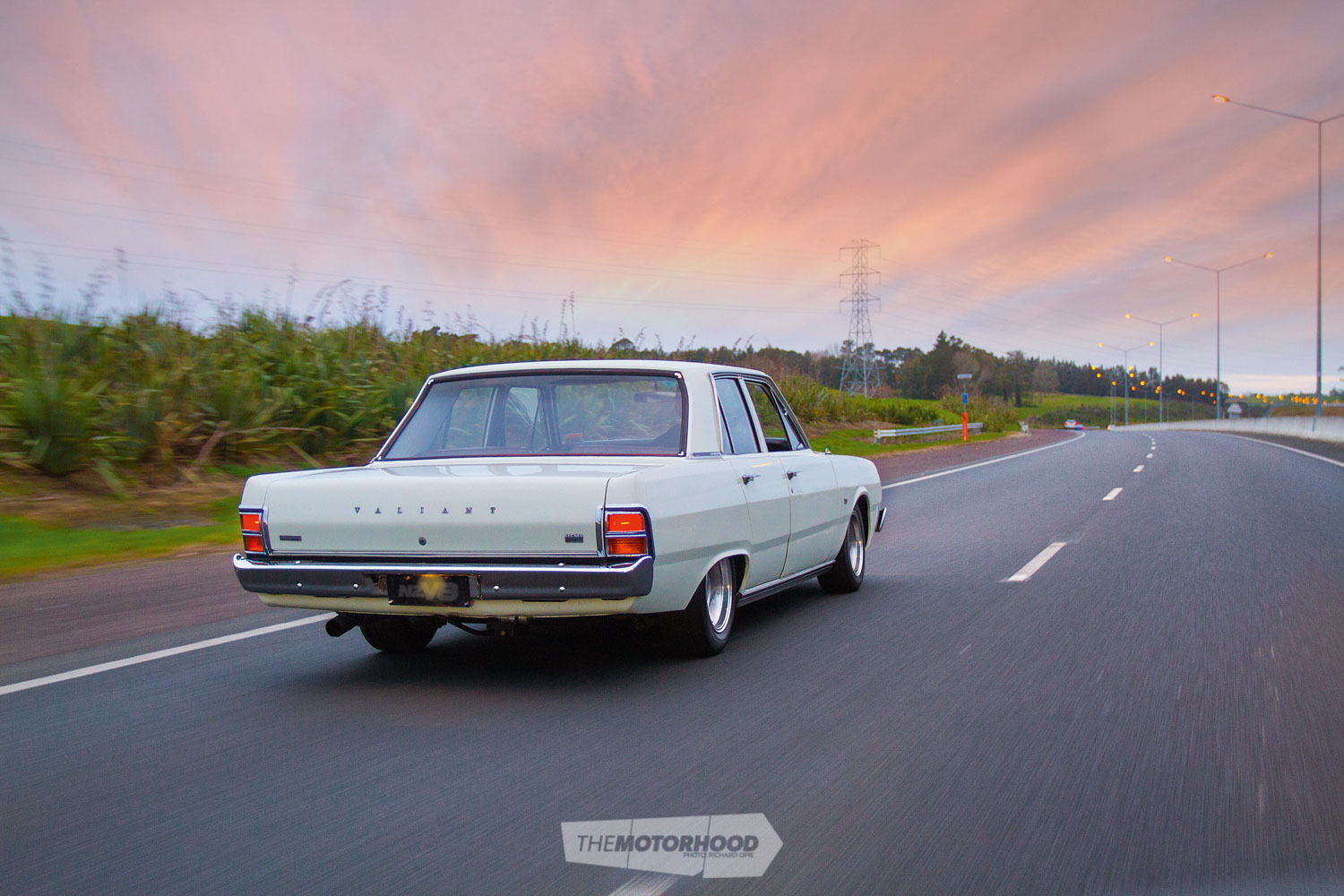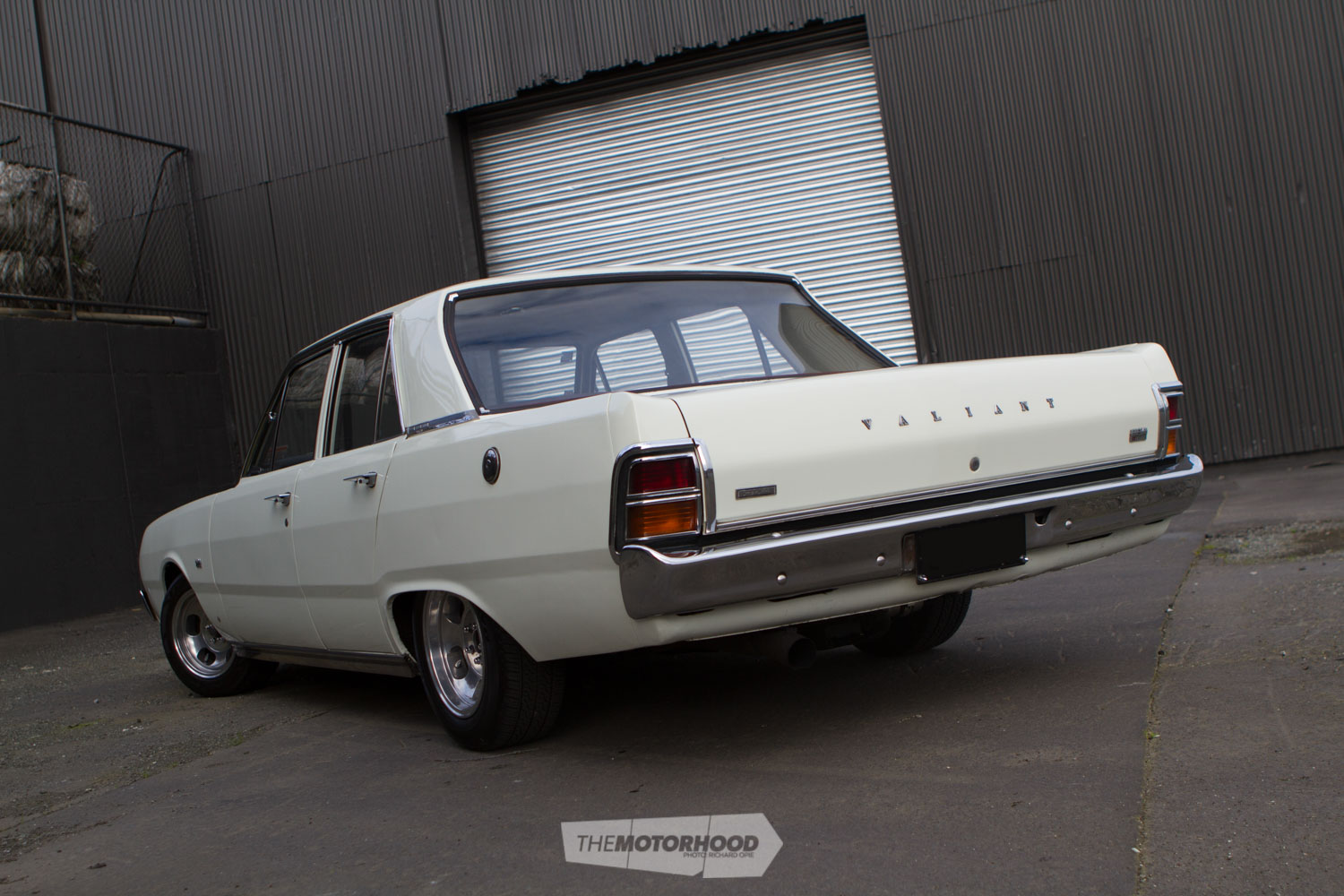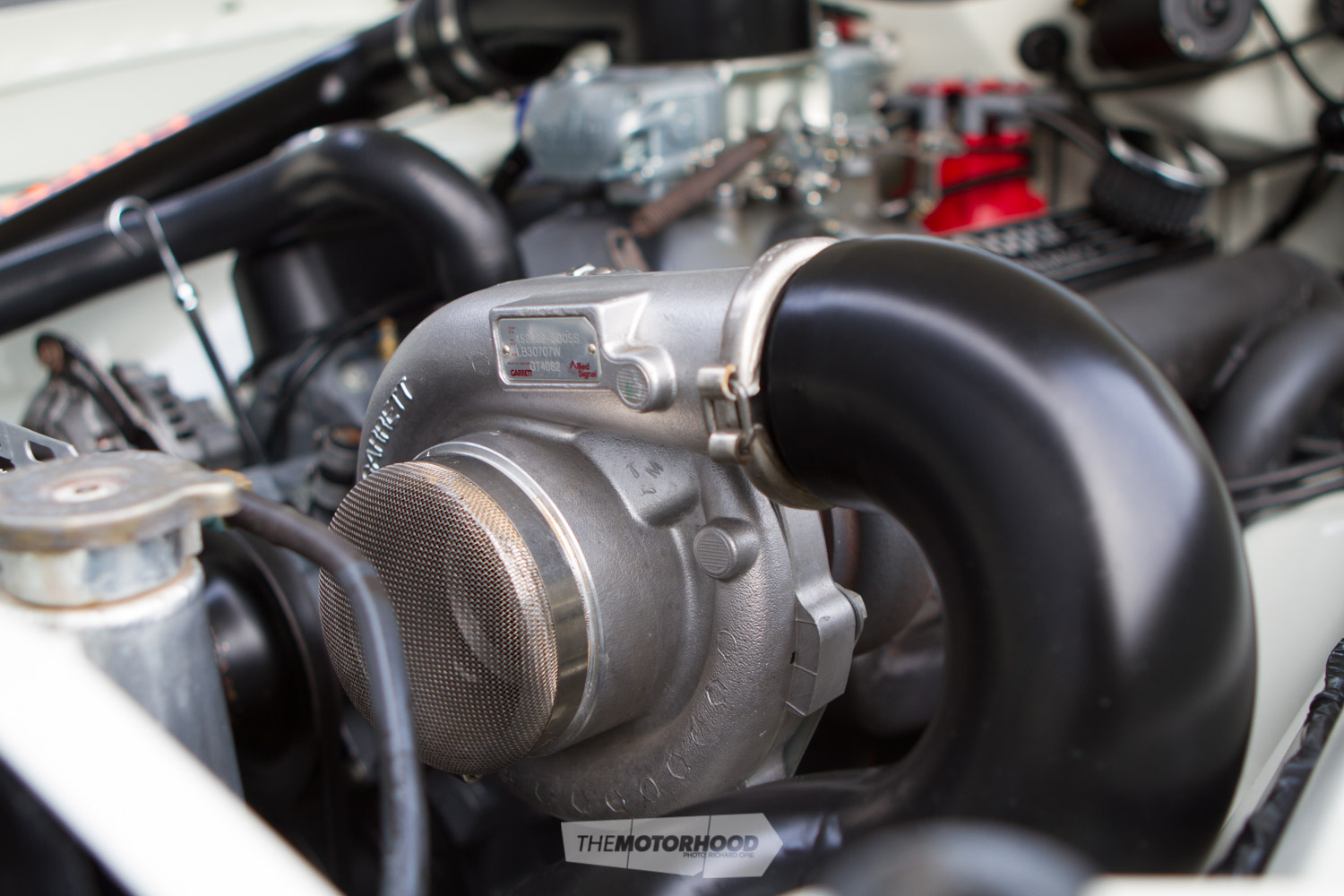It may look like Grandpa’s old Valiant, but this sucker packs a serious turbo punch!

As most of us get older, we start to realize that the great thing about being young and stupid is that we don’t understand just how stupid we are. As with many of us, Clint Field’s youthful stupidity came in automotive form. He got up to all the things that we openly refer to as ones you can’t get away with doing anymore. Of course, he had plenty of fun doing those things, and he was not alone. However, as he’s aged, he’s come to realize that a few of the cars he has sold are ones that he now wishes he still owned.
“I’ve always liked the shape of VGs. I had one when I was 18, and it handled a thrashing much better than the old English Fords that it replaced; column-shift manual made rollbacks so easy, and the diff didn’t explode as often,” he says, looking back fondly at his misspent youth.
Over the years, Clint’s love of all things automotive has seen him work his way up to becoming a LVVTA certifier. Of course, working in a role like that, you get exposed to a plethora of modified vehicles, and your dreams of owning such cars only get enhanced.

“The combo is nothing clever, just the correct combination of parts that are all stronger than those of the factory engine”
For many years, Clint was often seen driving a highly modified Nissan Navara, complete with airbag suspension and a Lexus V8 under the hood. As reliable and standout as the vehicle was, Clint started to find it uninspiring and wanted something better. As he also owned a motorbike, he was torn between sinking more money into the Nissan — money that he knew he’d never get back — and buying a bigger motorbike. While a bigger bike would give him the thrills he was after, his wife, never a big bike fan, wasn’t so keen on the idea.
It was this crossroads that led to the unexpected decision to sell both the bike and the Nissan and get something that both he and his wife could enjoy. Of course, it still had to be something Clint could tinker away with in the shed, and, as he was a VG fan from days of old, there was really no other choice.
Being an active member of the oldschool.co.nz forum, there was no way Clint was ever going to fit massive wheels and modern accessories to the car; instead, the idea was to keep it stock and as retro appearing as possible. But that didn’t mean that he couldn’t do something a bit more special under the hood.

“After buying it, I lowered it and put the wheels on, and cruised around like that for a while. I thought about putting a blower on it but decided against it, partially due to the engine being offset from the factory — none of it is in the middle, and the blower would bug me if it wasn’t centred in the bonnet. It’s not easy to move it across, as the trans tunnel is not in the middle, either. I’d had the idea of a turbo V8 for a while. It had the bonus of being fairly cheap in theory, and after I took out the rusty battery tray and put the battery in the boot, it left a turbo-sized gap,” Clint says of the newfound direction of the build.
The added bonus of the turbo set-up, besides the obvious spike in power, was that the offset engine also became far less obvious by filling the space on the passenger side. However, as we know, things that seem too cheap to be true usually are, and it wasn’t long before the build evolved from a cheapy into one that was done properly and built to last.
As Clint explains, “The original plan was to use a stock 318 bottom end and fit some 360 heads to it, to drop the compression. But then the ‘might as wells’ got me, so I rebuilt the block. I had some 360 heads that I was going to throw on, but they were a bit tired. I figured it’d be a shame to drop a valve through a newly rebuilt bottom end. I priced up rebuilding them, and it turned out to be cheaper to buy a complete set of Edelbrock heads.”

Blow-through Turbos
In a blow-through turbo set-up such as this, some trickery is required to ensure the carburettor can not only cope with the boost pressure but also work optimally. While most carb specialists won’t give away all their tricks, with some expert knowledge, it is possible to make blow-through set-ups work well. During modification, it’s not uncommon for the factory brass floats to be discarded and replaced with floats that are constructed of a solid Nitrophyl material, as the stock ones are hollow and can implode under high boost pressures. The power valves are also often modified, which can require the floats to be clearanced. In addition, power valves are used on both sides of the carburettor, letting in a little fuel from each side and allowing the opening points to be staggered to provide for more tunability. Each side can be set up to open at different boost levels to allow for a stable air–fuel ratio throughout the boost range.
By this stage, there weren’t a lot of factory Chrysler parts left in the engine, apart from the rockers — and, wouldn’t you know it, the new pushrods poked a hole in them at the very first drag meet to which Clint took the car. Out came the credit card once again to purchase a set of roller rockers and better pushrods; with that, the theory of using cheap or existing parts was totally gone. In saying that, Clint describes the combo as being nothing clever, just the correct combination of parts that are all stronger than those of the factory engine.
The rest of the engine combo is just as well thought out, and includes a Garrett turbo that reportedly was original equipment on a Scania truck — despite this, it seems to provide what Clint was after, and cost just a fraction of the equivalent ‘performance’-orientated version: “There’s almost no lag and it makes for a fun car to drive. The power comes on reasonably quickly without shock loading anything. I think that’s why the driveline has survived so well. It also makes it easy to drive on the street, as it doesn’t try to fry the tyres all the time.”
Clint kept costs down by keeping things simple rather than opting for fancy custom manifolds. He used the stock cast exhaust manifolds, and fabricated a collector to merge the two as well as mount the turbo. Of course, the exhaust and carb were areas that couldn’t be skimped on. To get rid of the spent gases, Clint fabricated his own three-inch exhaust set-up, which a 60mm wastegate also feeds into. For both looks and to keep under-bonnet temps down, the whole set-up has been HPC coated.
Air inhaled through the turbo is sent through a large front-mounted intercooler, which Clint made plenty of effort to conceal behind the stock grille. From here, it’s up to a 650cfm Demon carb through more custom piping. Getting the carb to work with the 10psi of boost was one of the trickier parts of the build, and one of the few bits Clint ended up outsourcing — he sent it to Jake’s Performance in Australia to be modified.

There is no big-dollar fancy system feeding fuel to the carb; once again, it is a smart combo that Clint knew would get the job done without breaking the bank. The stock fuel tank has been modified to include a sump, from which a half-inch line runs to a Bosch 044 pump. Up front is an Aeromotive rising-rate regulator to keep the fuel flowing when the boost comes on.
When it came to sorting the ignition, Clint knew there was really only one brand of products he could rely on to provide spark, and that was MSD. He sourced an MSD Pro Billet distributor, an MSD 6AL ignition box, and an MSD coil, which now work perfectly no matter how hard he pushes the car.

While it’d be natural to assume that Clint poured plenty of cash into the driveline to ensure it could handle the new load, you’d be wrong. “The TorqueFlite 904 transmission is a $300 Trade Me time bomb,” he laughs, but, due to the car’s small tyres, so far, it’s held together. The stock rear end hasn’t coped quite so well, with the 25-spline axles starting to show signs of twisting. At least, thanks to a four-spider LSD tweaked by Steelie Gears, both rear tyres turn at the same time when they need to.
While the plan right from the outset was to keep the exterior of the car looking as stock as possible, the same premise was never going to work under the hood. Instead, before fitting the motor, Clint set about smoothing out the engine bay before respraying it himself in the stock off-white colour.

So how does Clint find the car now it’s completed? “One of the best parts about driving it is the torque at small-throttle openings; it feels like a much bigger engine. It gets driven a fair bit. I like driving it, even if it’s just to go down to the shops — any excuse really,” he adds.
A serial modifier like Clint will never sit still for long, so there are more plans, as always. When asked about these, he tells us, “It’s getting to the point at which, to go faster, it needs a stronger diff and trans, so I can wind the boost up some more. It’s probably too good to pull apart for paint and interior work, but not good enough to be really nice, so I’ve bought a VG coupe that will be getting panel and paint done. I’ll take the engine out of this and put it in the coupe, with a tougher driveline and more power, and just drop a mild 318 into this.”
Sounds like Clint’s set to have the best of both worlds. Some guys have all the luck, huh?

Clint Field
Car club: Oldschool.co.nz
Age: 35
Occupation: Vehicle certifier
Previously owned cars: Two other VG V8 sedans, VH Valiant V8 ute, airbagged Navara with 1UZFE, turbo R32 Skyline coupe, assorted Escorts and Cortinas, etc.
Dream car: At the moment, a VG coupe; I’ve recently bought one — the next victim
Why the Valiant? To relive my misspent youth!
Build time: 18 months
Length of ownership: Five years
Clint thanks: My wife Michelle; Dave at Engine Parts Ltd; Dwight at Leading Edge Cylinder Heads; Nicholai at HPC; Alan and Julie at Thrill Performance; Tony at Steelie Gears; Mark and Janne at MS Vehicle Certification

1971 Chrysler Valiant
Engine: 318ci Chrysler small block, 318 LA block, bored 30 over, early factory forged crank, Scat rods, forged pistons, ARP fasteners, high-volume oil pump, Edelbrock alloy heads, Comp Cams double springs, Comp Cams roller rockers, Kelford Cams custom turbo-grind cam, Trend pushrods, Mopar M1 single-plane manifold, 650cfm Demon blow-through carb, Garrett GT4082 turbo, stock cast manifolds, 2¼-inch crossover pipe, 60mm wastegate, three-inch exhaust, modified fuel tank, Bosch 044 fuel pump, half-inch fuel lines, Aeromotive rising-rate fuel-pressure regulator, MSD Pro Billet distributor, MSD 6AL ignition, MSD coil, Afco alloy radiator, Davies Craig electric fan
Driveline: TorqueFlite 904 transmission, 2000rpm stall, Mopar performance flexplate, stock 2.92:1 BorgWarner diff, stock 25-spline axles, four-spider LSD
Suspension: Lowered torsion bars, two-inch lowering blocks, stock leafs, KYB shocks
Brakes: Stock vented discs, stock calipers, performance pads front; stock drums rear
Wheels/Tyres: 14×7-inch Trident rims, 195/60R14 and 205/60R14 tyres
Exterior: Stock
Chassis: Stitch-welded front chassis rail seams, strengthened suspension mount points, chassis connectors
Interior: Stock seats, Grant steering wheel, B&M ratchet shifter, Auto Meter gauges
Performance: 12.4s at 110mph











